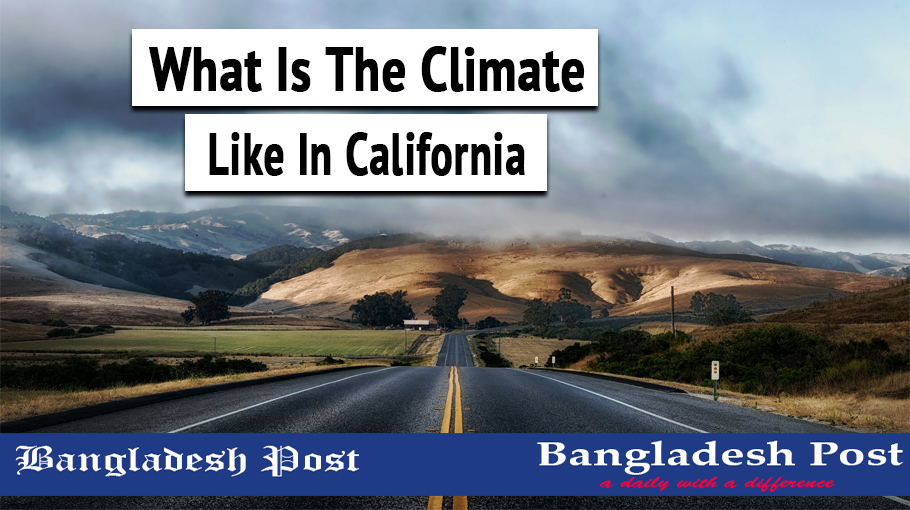What is the climate like In California

California belongs to a variegated climate ranging from a wet temperate rainforest in the north, hot, arid desert in the interior, alpine covered with snow in the mountains, and the torrid Mediterranean in the residuum of the state. The Pacific Ocean verges the western part of the state, Mexico the south, Arizona and Nevada the east, and Oregon the north. The state's diverse topography spreads the Sierra Nevada mountain range in the east to the Pacific Ocean on the west coast and the Mojave Desert in the south to redwood forests in the north.
The climate spreads from polar to subtropical because of the big size of the state. Summer fog is common on the coast because of the cold California current. On the other hand, inland areas feel hot summers and cold winters. Propinquity to the Pacific Ocean determines summer temperatures of parts of San Francisco and Los Angeles close to the coast and makes various microclimates as downtowns of these cities feel colder winters and hotter summer temperatures.
Northern parts of California are experiencing more rain than the south. That's because the high mountain slopes make an influence to the climate as western mountain ranges get more rain than the eastern leeward parts which reside in the rain shadow region. The high mountains on the western side contain an alpine climate, whereas those in the east experience cold winters and hot summers. A desert on the eastern side, Death Valley, is the hottest place with a recorded temperature of 134°F (56.7°C), whereas Boca is the lowest in the state with a recorded temperature of -45°F (-42.8°C).
Summers seem to be light along the coast like the San Francisco area with an average high temperature of 67°F (19.4°C) at the peak in August. On the contrary, the eastern and central parts of California seem to be hot with average high temperatures of 91°F (32.8°C) to 97°F (36.1°C) in Fresno and Sacramento. Winters approximate low temperatures would be on average of 40°F (4.4°C) to 50°F (10°C) in the coastal areas. Besides, Mammoth Lakes in the mountains of Sierra Nevada get colder and becomes freeze to an average low temperature of 15°F (-9.4°C). Spring is hotter and dumpy than the winter. On the other hand, autumn seems colder than the summer in almost every part of the state. Rainfall remains often at the time of winter in most parts of the state, and the annual precipitation in California would be 18" (457.2mm). Snowfall is regular in the northern alpine regions. To be specific, it can be in the average of 60" (1524mm) to 70" (1778mm) approximately over the year. Summer fog is an exclusive specification of the western coasts. Hence, frost is common at the time of winter in different parts of the state.
Read More: Best places to travel alone in USA
Weather hazards
California is located in the Pacific Ring of Fire. That endangers it susceptible to tsunamis, earthquakes, and volcanic activity. Many fault lines go through the state, like the Hayward Fault and the San Andreas Fault. These also pave the way to earthquakes of different intensities. There occurred about 37000 earthquakes in the state. Though many of them are so weak that people can not take notice.
In the dry summers, wildfires are a great threat. Those destroy often hundreds of acres of forestlands. Winds such as the Santa Ana include the severity of the breakneck climatic occasions.
Floods, landslides on steep terrain, and droughts happen in difficult parts of the state because of the diversity of weather patterns.
The best time to visit California
The best time to visit different parts of California might be during spring and autumn. Though some visitors are even well-to-do at the peak of summer.
Mid-spring is a great time to travel. The winter cold regresses, and the sun starts its duties in full glory. Western coastal regions like San Francisco have pleasant and light summer days in the 50°F (10°C) to 70°F (21.1°C) range. Up in the north, summers are lenient without fatalities of temperatures.
Autumn has light temperatures with a blob of rain, especially in the southern, central, and eastern parts of the state.
In general, both spring and autumn seem to be less hot and humid and are more comfortable than the summer in most of the areas of California.
The worst time to visit California
Winter from December to February is the worst time to visit most of California as the state experiences cold and chilly weather.
Northern California, with its highlands and mountain ranges, is chilly as the higher altitudes accumulate large amounts of snow often up to 100" (2540mm). On the western side, the coastal areas around the Pacific Ocean are relatively warmer compared to the inland regions, but temperatures are low during the winter nights. The deserts in the south also tend to be cold during the winter nights.
Though summers are avoidable in a few states, whereas winter is generally the most avoidable period in the rest of California.
So, what are you waiting for? Pack your bags and obtain ready for exploring the gorgeous North Carolina. Happy Journey!
Read More: First time overseas travel tips



